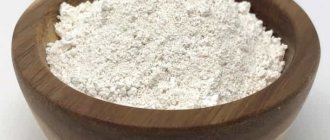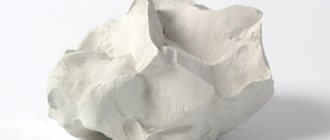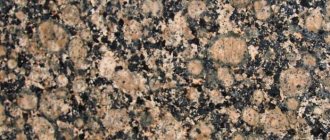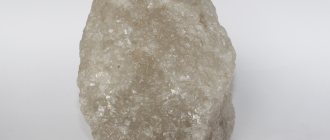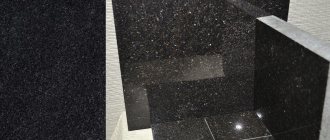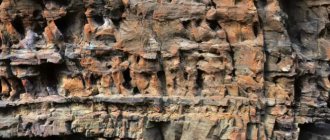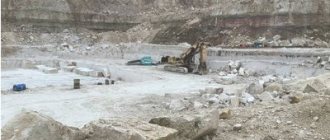High-quality kaolin from the Orenburg region will replace imported supplies
The prospects for the development of the field were assessed by the Minister of Natural Resources and Environment of Russia Dmitry Kobylkin during a working trip to the region. In the Svetlinsky district, where the surveys were carried out, the head of the Ministry of Natural Resources of the Russian Federation, the governor of the Orenburg region Denis Pasler and the general director of Rosgeologiya Sergei Gorkov got acquainted with the results of the search and assessment work.
White refractory clay is a valuable raw material for the production of ceramics, paper, cardboard, cosmetic products, rubber and plastic products, and artificial fabrics. So far, the needs of the domestic industry for high-quality kaolins are met through imports from Ukraine, Kazakhstan, the USA and Great Britain.
“The Koskol deposit of high-quality kaolins is the largest, unparalleled deposit in Russia with reserves of 405.8 million tons, with total reserves in Russia according to the State Balance Sheet of 418 million tons in 25 deposits, with low-quality kaolin,” emphasized Dmitry Kobylkin. — With the commissioning of the deposit in Russia, the problem of import substitution of high-quality kaolin will be completely resolved. This, without a doubt, will serve to strengthen Russia’s national mineral and raw materials security.
The head of the Ministry of Natural Resources of the Russian Federation noted that the region has every opportunity to create new mining and processing enterprises.
“For the Orenburg region, the discovery of a field and the start of production means an increase in economic potential,” stated the regional governor Denis Pasler. — Within the framework of the agreement, the regional government is ready to pay special attention to the training of competent personnel to work in the field of geological exploration on the basis of vocational education organizations. Rosgeology is also interested in this. This means that our graduates of specialized educational institutions will have good employment prospects.
As a result of the meeting, an agreement was signed on cooperation in the field of comprehensive geological study of the subsoil, reproduction of the mineral resource base, as well as monitoring the state of the subsoil in the region.
Help "RG"
A promising deposit in the vicinity of the Orenburg village of Koskul near the border with Kazakhstan was discovered in 2005-2008 during geological mapping work. In 2018-2019, a significant amount of field prospecting and assessment work was carried out here, more than 220 wells were drilled, 1,646 samples were taken and analyzed. Now the subsidiary of Rosgeologiya is completing the preparation of reporting materials based on the results of prospecting and assessment work for protection in the State Commission for Reserves.
Main deposits of kaolins and clays
Our country has huge reserves of clay raw materials. In the Ukrainian SSR, deposits of primary kaolins are exploited - Prosyanovskoe (Dnepropetrovsk region), Glukhovetskoe (Vinnitsa region), Dubrovskoe (Zhytomyr region) and secondary kaolins - Polozhskoe (Zaporozhye region), Novoselitskoe (Cherkassy region). In the Ukrainian SSR there are also deposits of high quality kaolin in Transcarpathia (Beregovskoe), primary alkaline kaolin in the Azov region (Manuilovskoe, Ekaterininskoe).
In the Urals, the Kyshtymskoye (Chelyabinsk region) and Eleninskoye kaolin deposits are being developed. The Alekseevskoye (Kokchetav region) deposit of primary kaolins can be a raw material base for factories in the Urals, Eastern Siberia and the Far East. In the Far East, the Svyatogorsk kaolin deposit is also being developed, and in the Primorsky Territory, a dacite porphyry deposit (“porcelain stone”) is being developed. In Central Asia there are the Angrenskoye (Tashkent region) deposit of primary and secondary kaolins, the Yablonovskoye deposit (Kazakh SSR), etc. It is possible to develop new deposits in the BSSR, Primorsky Territory and other economic regions of the country.
In the ceramic industry, refractory and refractory clays are widely used. Chasov-Yarskie (Donetsk region) refractory light-burning clays are the best for the production of fine ceramics. For these purposes, Druzhkovka, Novoraysk, Nikolaev, Nikiforov clays (Donetsk region) are also used.
In the production of refractories and chemically resistant products, clays from Artemovsk (Donetsk region) and Lukoshkinsky (Lipetsk region) are used. Latnensky (Voronezh region), Borovichi-Lyubytinsky (Novgorod region) clays are used in the production of refractories.
Clays from the Ural deposits: Belkin (Sverdlovsk region), Nizhneuvelsk (Chelyabinsk region) and others are suitable for the production of refractories, chemically resistant products, sanitary construction products from porcelain and semi-porcelain. In Siberia, clays from the Voronovsky (near Tomsk), Evsinsky (Novosibirsk region) deposits, etc. are used. Clays from the Beloe Glinishche (near Karaganda), Tankerskoye and Aizin-Tamara (near Tselinograd) deposits are suitable for the manufacture of fire-resistant supplies. In the production of porcelain products, these clays, like many of those previously listed, can only be used after enrichment.
The main bentonite deposits are Oglanlinskoe (Turkmen SSR), Gisibrinskoe and Askanskoe (Georgian SSR), Pyzhevskoe, Cherkasskoe, Gorbskoe, Kurtsevskoe (Ukrainian SSR), etc.
Assessing the quality of clays and kaolins taking into account the requirements for the production of fine ceramic products, it should be noted that the kaolin from the Prosyanovsky deposit is the best. It contains hydromica, quartz sand (up to 45%), and undecomposed grains of feldspar as impurities. Kaolin is divided into grades - highest, I, II and III (GOST 6138-61). In the highest grade kaolin, the content of coloring oxides is 0.8%; I grade - 1; II - 1.4; III - 1.8%. For the production of household and artistic porcelain, kaolin of the highest and first grades is used, for the production of sanitary-building faience and semi-porcelain - grades II and III.
Kaolin from the Glukhovetskoe deposit is divided into grades I, II, III and IV. The main impurities are quartz (up to 60%), biotite, magnesite, rutile, etc. This kaolin is finely dispersed, has little plasticity, and has a pale cream tint. The content of coloring oxides (Fe2O3 + TiO2) in grade I kaolin is up to 1.3; II - up to 1.8; III - up to 2.2; IV - up to 2.9%. It is used to make earthenware and fireproof supplies.
Chasov-Yarsky refractory, light-burning clays are finely dispersed (the content of particles less than 0.005 mm in size reaches 96%), have a large sintering range: for the main varieties of clays 600-700 ° C, for semi-acid clays 300-400 ° C. The starting temperature of sintering is 1000-1250 ° C C. Clays are divided into grades: basic clays - 40, 41, 42; semi-acid - 43, Ch1PK, Ch2PK. Fe2O3 content in clays 40 to 1.3; in clays 41 - up to 1.6; 42 - 2.3; 43 - no more than 3%. For other grades, the Fe2O3 content is not regulated.
Druzhkovka clays are fire-resistant, low-caking (550°C). They are developed at two fields: Veselovskoye and Novoraiskoye. Clays from the Veselovskoe deposit, in accordance with MRTU 14-06-27-63, must be supplied to the porcelain industry in three grades: DVF (porcelain), DVO (selected) and DV1 (grade I) - and contain Al2O3 + TiO2 per calcined substance of at least 33— 35%, Fe2O3 - no more than 1.4%. Clay from the Novoraisky deposit for the porcelain industry is supplied in two grades: DN-0 (selected) and DN-1 (grade 1). The content of Al2O3 + TiO2 in them should be, respectively, no less than 34-35%, and Fe2O3 no more than 1.3-3%.
Troshkovskaya clay is light-burning, fire-resistant, differs from ordinary clays used in the porcelain and earthenware industry in that, being in a “stone-like” state, it almost does not soak in water and does not swell. The dense kaolinite variety of clay contains small amounts of montmorillonite and is light and dark gray to brown in color when wet. Forms a plastic dough only after long-term fine grinding in a ball mill. The content of montmorillonite reaches 50%, in the “loose” variety up to 80-90%. Clay is divided into highest, 1st and 2nd grades. The Al2O3 content is no less than 32.30 and 30%, respectively, and the sum of Fe2O3 + TiO2 is no more than 1.3; 1.6; 2.5% - The highest and first grades of this clay are used for porcelain products, grade II is used for refractory supplies. Products made from masses based on Troshkinsky clays have increased whiteness and translucency.
Latno clays are finely dispersed (0.001 mm 50-70%), highly refractory, as they contain up to 83% kaolinite and less often hydromica. The color is light and dark gray to black (charcoal). The main clays are divided into grades: LT0, LT1, LT2 and LTZ (selected, I, II and III grades); semi-acid grades: LT1PK, LT2PK and LTZPK. Carbonaceous clays have one grade of LTU. The Al2O3 content ranges from 30 to 41%, Fe2O3 no more than 2.5%. Due to the high content of coloring substances, Latna clays are used in the production of refractory materials.
How is kaolin extracted?
Open method (example), two benches using two crawler excavators and transporting minerals with three dump trucks. Initially, it is planned to locate the quarry within the boundaries of the mining allotment on an area of approximately 50 hectares. After five years of operation, it is planned to advance the quarry within the mining allotment by approximately 30-40 meters per year with further reclamation of its mined-out part and transfer of land for agricultural needs. It is planned to build a raw material enrichment plant near the quarry. The extraction of kaolin has its own specifics, since the clay is highly saturated with moisture. On the one hand, this makes the raw material heavier, on the other hand, it becomes less dusty, as is the case with the development of sand or granite quarries.
Technical characteristics of white clay
Kaolin is one of the most commonly used fillers in the production of rubber, plastic, paint and varnish and many other types of products. The widespread use of ground clay is due to different fractions (size of ground particles). Depending on the needs of your production, you can buy kaolin of any brand. Below are the technical characteristics of brands of ground white clay (there is an option to save it on your computer).
KR-1, KR-2 (GOST 19608-84) - technical characteristics:
KCh-V, KCh-1, KCh-2, KCh-3 (TU 08.12.21-002-05494314-2019) - technical characteristics:
KBC-1, KBC-2, KBC-3 (TU08.12.21-002-05494314-2019) - technical characteristics:
Chemical composition of koalin
The main component of the chemical composition is kaolinite, a mineral from the group of hydrous aluminosilicates. Thanks to it, kaolin is light-colored, mostly white, with a slight yellowish, bluish or greenish tint - this depends on the presence and amount of impurities: copper, zinc, iron and others.
The composition also contains microelements that bring considerable benefits to the human body:
- silica (silicon dioxide) - increases immunity, stimulates metabolic processes, strengthens blood vessels, has a beneficial effect on skin elasticity;
- magnesium - normalizes the excitability of the nervous system and muscle tone, strengthens bones, activates protein compounds important for growth and normal functioning;
- calcium - participates in hematopoiesis, strengthens muscles and bones;
- iron - improves the supply of oxygen to the body's cells;
- phosphorus - has a positive effect on the functioning of the nervous system, brain and bone marrow.
It is important that kaolin contains beneficial microelements in easily digestible forms.
Okay, who is investing in the development of the Zaporozhye field?
Belyaevsky Concentrating Plant LLC is wholly owned by Alexander Votintsev , who owns a number of enterprises, the most famous of which is Odessa, which built a port grain terminal in the port of Nikolaev. “Belyaevsky Enrichment Plant intends to invest from 15 to 30 million euros in the development of the field,” Votintsev . The production will also create about 100 jobs. The company has already announced its social obligations.
Properties of kaolin
The components that make up kaolin determine its physicochemical, pharmaceutical and other properties.
Physico-chemical characteristics
White clay has low abrasiveness - the substance is characterized by a layered structure and some oiliness.
Untreated natural kaolin does not dissolve completely in water and organic acids.
It belongs to coarse varieties of clay, that is, it consists of large particles that are poorly connected to each other. Therefore, in its raw form, the substance is non-plastic and crumbles easily. However, when dried and fired, when the water has evaporated from the composition, it acquires good mechanical strength.
Experts from various industries note the weak electrical conductivity of kaolin, which increases the safety of using this clay and the ability to make protective elements from it for electrical networks and electrical appliances.
The mineral is characterized by high fire resistance - the minimum melting point is 1750 degrees. Therefore, white clay is applicable for the production of building ceramics and other fireproof products.
The minimum of coloring substances in the composition and chemical inertness make it possible to make dishes from kaolin, which is important for adherents of environmentally friendly living.
Sorbent properties
Kaolin is an excellent sorbent, i.e. it is capable of selectively absorbing substances. When ingested into the body, white clay actively absorbs:
- toxic compounds;
- waste products of bacteria and natural cell decay;
- radioactive components;
- heavy metals;
- slags
Having absorbed harmful substances, kaolin removes them from the body, thereby benefiting human health.
The sorbing properties of white clay have been known for several centuries. People identified them by observing animals eating poisonous berries, followed by kaolin, which suggested its healing potential. Clay began to be added to food and drink, and used for the prevention and treatment of diseases and poisoning.
Where is the mineral mined?
The places where kaolin is mined are determined by the characteristics of its formation.
- Primary, sedimentary white clay, formed as a result of weathering and decomposition of rocks, is found at a depth of 5 to 50 meters. Externally, kaolin deposits resemble nests or curls. The minimum thickness of such clay accumulation can be 2 meters, the maximum - 120.
- Secondary type kaolin (redeposited) is obtained as a result of erosion and subsequent deposition of rocks. Layers of clay are found in sand. The thickness of such deposits is about 20 meters, but no more than 20% of them can be used (that is, it is permissible to take secondary mineral from a depth of maximum 4 meters).
Geologists currently estimate global reserves of kaolin at 15–16 billion tons. Deposits up to 5 million tons are considered small, over 30 - large. Deposits of white clay are found in the following areas:
- Europe - in Bulgaria, Hungary, Great Britain, Poland, Russia, Germany, Ukraine, Spain, Finland, Portugal, Czech Republic;
- Asia - in China, Uzbekistan;
- both American continents - Brazil, USA;
- Africa - in Angola, Kenya.
Since kaolin is a clay, it is found in the upper layers of the earth's crust. This location determines the optimal mining method - open pit.
Is everything really like that?
No. To date, numerous examinations have been carried out in leading institutes of the country and conclusions of scientists have been prepared, which have shown that kaolin in the Belyaevskoye deposit is harmless to human health. Investors prepared a report to the Ministry of Ecology on environmental safety on the operation of the future quarry. The report is currently undergoing public comment. After which appropriate conclusions will be drawn by specialists from the Ministry of Ecology.
What is kaolin?
In its simplest sense, kaolin is white clay. It is used most often in ceramics. However, when enriched, that is, increasing the concentration of the kaolinite mineral in the raw material, it becomes brown in color. Kaolin is a component of many materials - paper, rubber, paint. It is also used in the food industry and cosmetics. The clay got its name from the Chinese locality of Kaolin, where its large deposits were first discovered. Kaolin deposits are assessed by the size of reserves and their quality.
